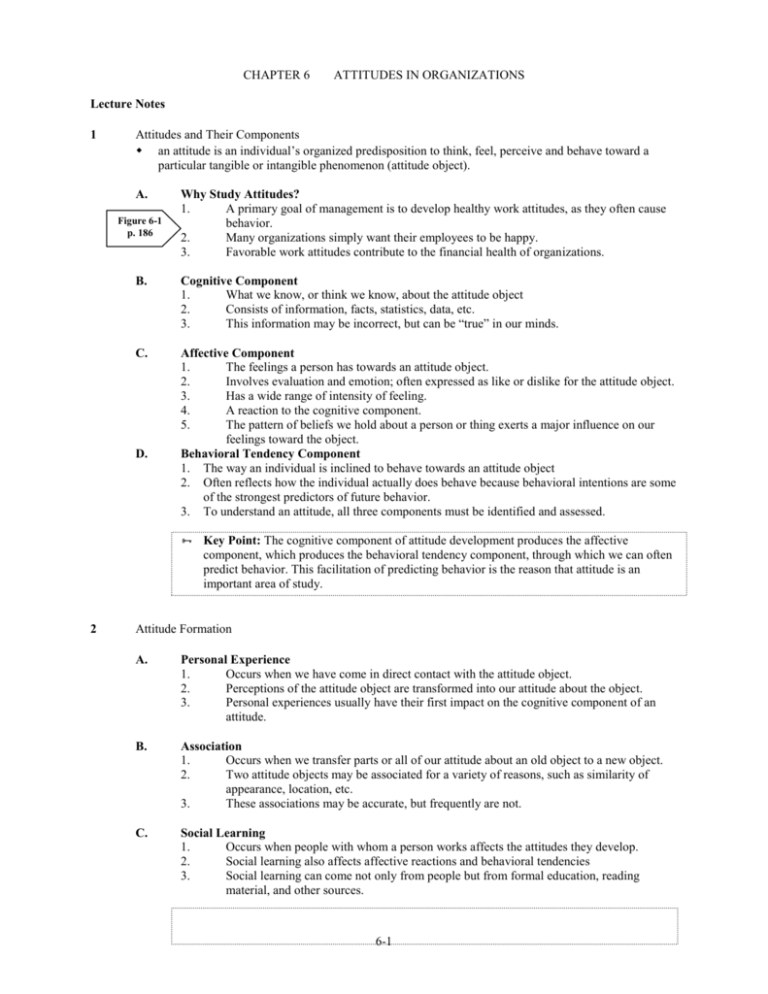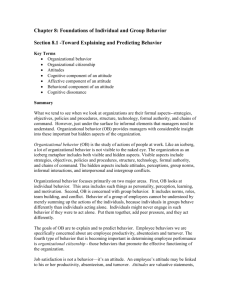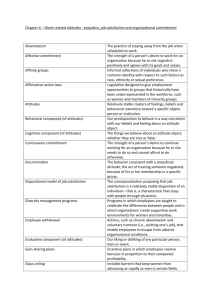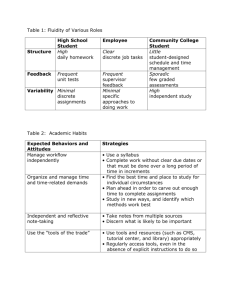organizational affective
advertisement

CHAPTER 6 ATTITUDES IN ORGANIZATIONS Lecture Notes 1 Attitudes and Their Components an attitude is an individual’s organized predisposition to think, feel, perceive and behave toward a particular tangible or intangible phenomenon (attitude object). A. Figure 6-1 p. 186 Why Study Attitudes? 1. A primary goal of management is to develop healthy work attitudes, as they often cause behavior. 2. Many organizations simply want their employees to be happy. 3. Favorable work attitudes contribute to the financial health of organizations. B. Cognitive Component 1. What we know, or think we know, about the attitude object 2. Consists of information, facts, statistics, data, etc. 3. This information may be incorrect, but can be “true” in our minds. C. Affective Component 1. The feelings a person has towards an attitude object. 2. Involves evaluation and emotion; often expressed as like or dislike for the attitude object. 3. Has a wide range of intensity of feeling. 4. A reaction to the cognitive component. 5. The pattern of beliefs we hold about a person or thing exerts a major influence on our feelings toward the object. Behavioral Tendency Component 1. The way an individual is inclined to behave towards an attitude object 2. Often reflects how the individual actually does behave because behavioral intentions are some of the strongest predictors of future behavior. 3. To understand an attitude, all three components must be identified and assessed. D. Key Point: The cognitive component of attitude development produces the affective component, which produces the behavioral tendency component, through which we can often predict behavior. This facilitation of predicting behavior is the reason that attitude is an important area of study. 2 Attitude Formation A. Personal Experience 1. Occurs when we have come in direct contact with the attitude object. 2. Perceptions of the attitude object are transformed into our attitude about the object. 3. Personal experiences usually have their first impact on the cognitive component of an attitude. B. Association 1. Occurs when we transfer parts or all of our attitude about an old object to a new object. 2. Two attitude objects may be associated for a variety of reasons, such as similarity of appearance, location, etc. 3. These associations may be accurate, but frequently are not. C. Social Learning 1. Occurs when people with whom a person works affects the attitudes they develop. 2. Social learning also affects affective reactions and behavioral tendencies 3. Social learning can come not only from people but from formal education, reading material, and other sources. 6-1 6 Attitudes in Organizations Key Point: Social learning of work attitudes is especially powerful for new employees of an organization. D. 3 Heredity 1. Some studies suggest that people have genetic predispositions to develop certain types of attitudes. 2. Recent research suggests that up to 30% of the attitudes we possess, especially the affective component, may be due to our heredity. Attitude Change A. Strategies for Change 1. Strategy #1: Try to directly change one of the attitude components to change the cognitive component, present new information or modify the person’s existing beliefs if you succeed in changing the cognitive component, it may cause a change in the affective component as well, so most attitude change interventions focus on cognitive components to change the affective component, state that you and others have a different emotional reaction changing the cognitive and/or affective components may lead to changes in the behavioral tendency component to change the behavioral component, tell the other person how you plan to behave towards an attitude object 2. If new information about an attitude object conflicts with existing information, it has the potential to change attitudes -- but it usually doesn’t. often this information is filtered out of a person’s consciousness as unnecessary 3. Cognitive dissonance occurs when people are encouraged to develop a different belief about an attitude object. cognitive dissonance is an unpleasant psychological state people will often perceptually distort the cognition rather than change their overall attitude this reduces the likelihood of attitude change occurring it is best to attempt to change attitudes incrementally 4. Strategy #2: Provide them with a new experience with the attitude object that conflicts with the person’s prior attitude 5. Strategy #3: Try to create new associations with the attitude object 6. Strategy #4: Rely on social learning effects people are more likely to change an attitude if someone else who is more knowledgeable about, or has had greater experience with, an attitude object has a different attitude toward the object another way to use social influence is to cite the attitudes and beliefs of someone who has a favorable image Key Point: Research indicates that the cognitive and affective components are equally amenable to change. BUT - attitude change will be more effective if you use a change strategy that matches the origin of the attitude. 7. Strategy #5: First try to change the individual’s behavior behavior change can lead to attitude change e.g., public school integration Key Point: Many managers exert most of their effort on managing behavior rather than attitudes. In failing to recognize the link between the two, managers are unable to take advantage of the fact that positive attitudes can create a basis for desirable behaviors. 6-2 6 Attitudes in Organizations 4 Work-Related Attitudes A. Figure 6-2 p. 194 Job Satisfaction 1. Job satisfaction results from the appraisal of one’s job as attaining or allowing the attainment of one’s important job values, providing these values are congruent with or help to fulfill one’s basic needs. 2. Facets of job satisfaction job content: the work itself, what one does day to day on the job job context: all other facets providing the environment in which the job is performed each of these facets is associated with a corresponding dimension of the work environment each is related to the corresponding cognitive component of your attitude toward work feelings about one facet can spill over and influence your feelings about other facets 3. Overall job satisfaction describes a person’s overall affective reaction to the set of work and work-related factors if you consider only the overall satisfaction level, you would not have a complete picture of an individual’s job satisfaction although two employees may feel the same level of job satisfaction, behavioral tendency components (work behavior) of their attitudes may be very different due to differences in facet satisfactions 4. Causes of job satisfaction experience with various elements in the work environment job content factors shape job satisfaction/dissatisfaction job enrichment: organizations’ attempt to make jobs more interesting association if an employee’s job is similar to one he/she had in the past, prior satisfaction levels may be generalized to the present job people are quite consistent in the levels of job satisfaction they develop throughout their work lives social learning members of work groups often tend to feel the same way about job elements employees reinforce each others’ comments and reactions some research shows that the effects of social influence can be quite substantial other causes genetic predisposition to a certain level of job satisfaction personality: people high on negative affectivity are generally less job satisfied Key Point: Managers need to consider carefully their philosophies towards employees and the organization as ultimately affecting job satisfaction -- and consider new ways to promote favorable attitudes. Sabbaticals - Not Just for Academics Anymore: An Inside Look In the past decade, the corporate world has seen a shift in employee desires and motivations. In an effort to increase employee loyalty and motivation, some corporations are reviving the sabbatical concept. Sabbatical policies differ widely. Some companies offer employees five days off per year, while others offer the opportunity to take as much as two years of unpaid leave. While employees are on sabbatical, many organizations use the time to develop talent internally by allowing a person with less responsibility to learn the absent employee’s job. 6-3 6 Attitudes in Organizations Sabbatical policies do have their opponents, however. Some fear that employees will use their sabbatical time to search for a better position. Others note the difficulty in having employees who remain at work cover their own responsibilities and the responsibilities of their coworker who is on sabbatical. Some of these companies offer vacation bonuses and other flextime options instead. Regardless of specific policies, companies with a sabbatical policy recognize that their employees have lives and goals outside of their careers. 5. Measuring job satisfaction job satisfaction cannot be measured directly. indirect measurement of job satisfaction observation of worker behavior interviews with workers paper and pencil questionnaires most measures of satisfaction used today have poor reliability and validity however, a few good measures do provide high quality measures of satisfaction “Faces” technique Minnesota Satisfaction Questionnaire (MSQ): more precise than Faces, takes longer Job Descriptive Index (JDI): addresses the cognitive component each of these approaches can be used with a wide range of employees and organizations 6. Consequences of job satisfaction employees who are satisfied with their jobs are less likely to quit, be absent or tardy, or refuse to be good citizens job satisfaction is one of the strongest determiners of citizenship behaviors most studies have shown no relationship between job satisfaction and performance there is some evidence to support the argument that performance causes satisfaction, not that satisfaction causes performance Figure 6-3 p. 197 Table 6-1 p. 199 Self-Assessment: Minnesota Satisfaction Questionnaire, p. 198 Key Point: The observation of a weak causal relationship between satisfaction and performance may be due to poor measurement of performance within organizations. B. Organizational Commitment 1. The relative strength of an individual’s identification with and involvement in a particular organization. 2. Characterized by three factors: strong belief in and acceptance of the organization’s goals and values willingness to exert considerable effort on behalf of the organization strong desire to maintain membership in the organization 3. Much of the importance of organizational commitment lies in its behavioral tendency component -- acts of good citizenship, absenteeism, and turnover behaviors. 4. Components of organizational commitment affective commitment results from an emotional attachment to the organization and its mission (emotional attachment) employees feeling affective commitment are likely to continue commitment as long as the organization treats them well normative commitment is based on the belief that commitment is the “right” thing to do (obligation) employees feeling normative commitment may stay even in the face of poor treatment they feel that they ought to do so continuance commitment is based on the costs a employee associates with leaving the organization (calculative and rational) 6-4 6 Attitudes in Organizations 5. Figure 6-4 p. 202 C. Figure 6-5 p. 203 employees feeling continuance commitment will stay as long as they have no better opportunities in other organizations in the meantime, they may work only hard enough to be retained by the organization Causes of organizational commitment managers can choose employees who are likely to become committed by knowing about the factors which lead to organizational commitment the nature of the work that people perform involvement-oriented work often leads to stronger commitment than routine, repetitive work organizational commitment to the employee commitment BY the organization develops trust, generates and maintains employee commitment to the organization important for the development and sustainment of high-involvement organizations Recent Research on Job Satisfaction and Organizational Commitment 1. Lease: research on causes of job satisfaction and commitment 2. Consistent predictors of satisfaction and commitment: career stage work-family conflicts supervisor support promotional opportunities 3. Many of these determinants of satisfaction and commitment can be proactively managed. D. Job and Work Involvement 1. Job involvement: employees’ psychological involvement with a particular job 2. Employees with a high level of job involvement are strongly psychologically attached to their jobs. 3. Work involvement: employees’ devotion to or alienation from work in general 4. Although job and work involvement are often similar, they can differ substantially. 5. Both job and work involvement include three aspects conscious desire to participate actively in or to avoid a job or work in general extent to which a person considers job and work central or marginal to his/her life how important the work or job is to a person’s self-concept E. Psychological Ownership 1. The state where an individual feels as though the target of ownership (or a piece of that target) is theirs 2. In the work environment, this state attaches to work and to the organization. 3. One study found that a company’s sustainable market share is directly related to the quality experienced by the customer, which is a reflection of the degree of employee commitment and psychological ownership. 4. A sense of ownership develops through: empowerment self-management opportunities expanded roles in managing the production process participation in organizational problem solving Key Point: It is through control of the target that individuals come to experience a sense of ownership for that target. Figure 6-6 p. 204 5. Consequences of psychological ownership more personal risk more constructive helping behaviors greater personal responsibility for work and organizational outcomes more job satisfaction 6-5 6 Attitudes in Organizations 5 The Importance of Work-Related Attitudes 6 The more dissatisfied the workforce, the more frequent the incidents of counterproductive activities Employees who experience psychological ownership tend to be among the organization’s highest performers The Management of Employee Attitudes Figure 6-3 p. 197 7 more organizational commitment The nature of work and the design of employees’ jobs are two of the most important determinants of employees’ work-related attitudes. Routine, repetitive, short-time cycle, and low-skill jobs produce lower levels of motivation and satisfaction. Nature of work is frequently more important than company policy, the nature of supervision, and organizational structure in its impact upon member attitudes. Key Point: A significant part of the management of employee attitudes should be directed toward the nature of work and the design of jobs. Risks of favorable attitudes marginal performers with high job satisfaction are unlikely to quit, though it may be to the organization’s advantage for them to leave high organizational commitment often entails commitment to detrimental processes as well psychological ownership can lead to conformity behavior and groupthink psychological ownership can lead to selfish possessiveness, preventing effective team behavior The Financial Impact of Attitudes in Organizations A. Fundamentals 1. Human resource accounting: applying accounting principles and practices to the evaluation and management of human assets 2. Behavioral accounting: treating attitudinal measures as indicators of subsequent employee behaviors, which have economic implications that can be assessed using costaccounting procedures 3. This is a controversial process; not nearly as precise as traditional cost accounting. 4. These procedures are not capable of proving cause-effect relationships B. A Procedure for Measuring the Financial Impact of Attitudes 1. Step 1: Identification and measurement of relevant attitudes use behavioral research literature to identify those attitudes which have been related to behaviors in other organizations which are similar to yours identify the wide range of job satisfaction facets related to behaviors measure the relevant attitudes with a reliable, valid measure 2. Step 2 : Identification and measurement of relevant “cost items” identify and measure behaviors expected to have a relationship with the attitudes in step 1 steps 1 & 2 are usually conducted concurrently look in literature for behaviors which have been related to attitudes in similar situations determine whether these behaviors exist in your situation, and to what extent measure the behaviors with a reliable, valid measure. 3. Step 3: The pricing of behavioral “cost items” Macy and Mirvis provide extensive suggestions for the pricing of behaviors 4. Step 4: Identification of the relationship between attitudes and behavioral “cost items” 6-6 6 Attitudes in Organizations 5. estimate the nature of the attitude-behavior relationships in your organization is there a relationship between this attitude and this behavior? how strong is the relationship? Step 5: Estimation of the financial impact of attitude changes estimate the likely impact of an increase or decrease in attitude levels Key Point: Attitudes in organizations affect not only managers and members of the organization, they also directly affect the organization’s bottom-line profits. C. Some Qualifying Remarks 1. The time lag selected for examining the impact of attitudes on behaviors is critical. 2. It is important for an organization to continue to study the relationship between attitudes and behaviors over time, as it can change. 3. If two or more attitudes included in the same financial analysis are strongly related, overestimates of the behavioral impact of attitude change could occur. An Inside Look: An Estimate of the National Financial Impact of Attitudes An analysis was conducted to obtain a rough estimate of the direct financial impact that would occur if job satisfaction increased an average of .1SD across all members of the American work force. The result of the analysis was an estimated $2,319,100,000 total financial impact!! 6-7









